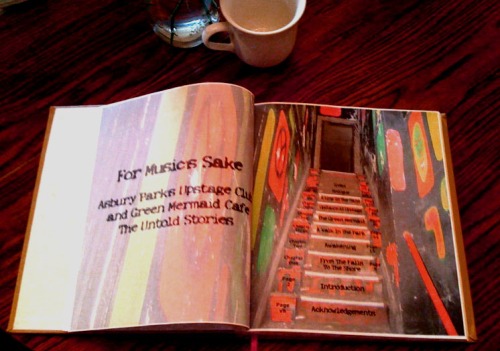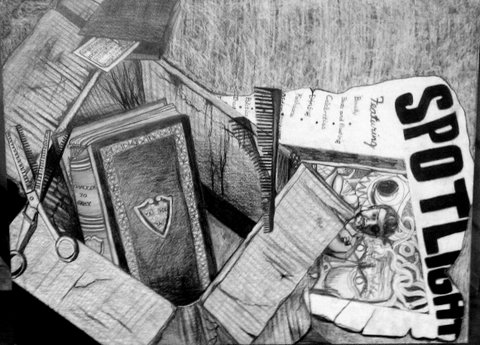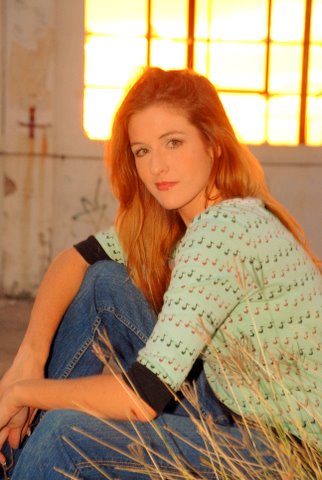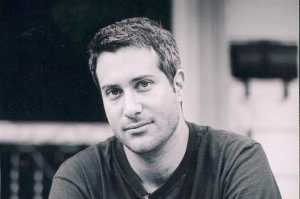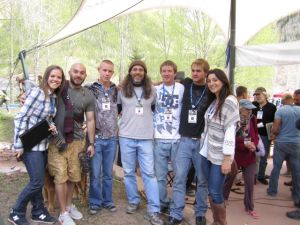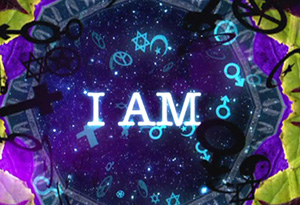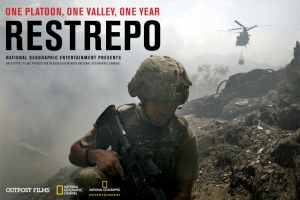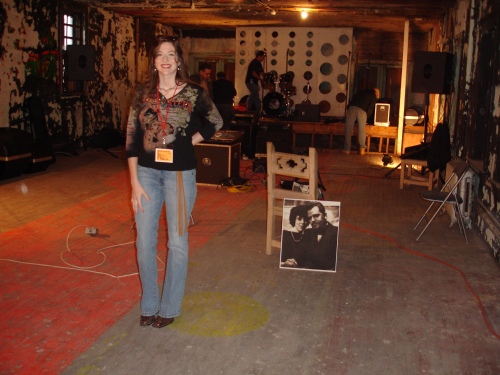
FOR MUSIC’S SAKE: Asbury Park’s Upstage Club and Green Mermaid Cafe – The Untold Stories
by Carrie Potter Devening
255 pages
To order: http://www.authorhouse.com/Bookstore/BookDetail.aspx?BookId=SKU-000411026
Or: http://theupstageclub.blogspot.com/
A short time ago, I reviewed a new book (http://bit.ly/ovt5v5) by the daughter of club manager Tom Potter, about the people who created, performed at and frequented the famous Upstage Club in Asbury Park, New Jersey. While The Stone Pony is the bar that is most associated with the early days of Bruce Springsteen, Southside Johnny and dozens of other Jersey Shore bands, it was actually an after-hours club called The Upstage where most of these musicians met, made friends, jammed, formed bands and cut their musical teeth.
Now in Part Two, I talk to the author, Carrie Potter Devening, about creating the book, the many friends who helped her make it a reality and her vision for the future of The Upstage Club.
This Hard Land: When did you first become interested in the history of the Upstage Club?
Carrie: I’ve been interested my whole life, mainly because of my family history and my love for my Grandpa Tom (Tom Potter, manager of The Upstage Club) When I was in high school, I would often use artwork done by my grandfather to inspire me. He was a very artistic man. For example, I remember one assignment we were given was to do a black and white still drawing off a cardboard box full of my favorite things from my Grandpa. This included a book of poetry that my grandfather used to challenge me to memorize; the Spotlight Magazine article which featured Grandpa Tom; a set of his scissors and his license to be a hair stylist. I still cherish that cardboard box to this day.
Carrie: I knew the family history was very unique and that Tom Potter and his wife Margaret and The Upstage Club were very important to so many people who were part of the Sound Of Asbury Park (S.O.A.P) and desperately wanted the memory of the Upstage preserved. You could say that this book has been in my creative storage bin for many, many years.
This Hard Land: When did the idea of writing a book about it begin to take shape?
Carrie: I really didn’t think a book was feasible until my late Uncle Geofrey (Tom Potter’s oldest son), who passed away just a few weeks ago, came to Texas.
He had read Gary Wien’s book, “Beyond The Palace,” (http://www.amazon.com/Beyond-Palace-Gary-Wien/dp/1412003148) which goes into quite a bit of detail about The Upstage. He encouraged me to speak to Gary Wien. Gary gave me a really good indication of how folks who had been part of the Upstage scene still felt about the club.
I had kept, literally, hundreds of slides (Tom Potter collected slides of photographs), I had his old scrapbook, and basically two big old storage bins full of memorabilia, including the famous Green Mermaid painting. None of these photographs had ever been published or really seen by anyone, including some great shots of Bruce Springsteen, Little Steven, Southside Johnny and basically all of the musicians who jammed at the Upstage. It was a real “treasure chest” of pictures and artwork that was just sitting in storage. So I took stock of all I had and said to myself, “I think I have the beginnings of a really great book here.”
In December of 2003, I got on a plane and flew to New Jersey and Asbury Park for the first of what would be more than a dozen trips. I checked into a room at the Manchester Inn in Ocean Grove, which sadly no longer exists after it burned to the ground. But for the longest time that hotel was my home base away from home, each and every time I came to Asbury Park.
First thing I did was meet face-to-face with “Beyond The Palace” author Gary Wein, as well as a friend of my grandfather, David Mieres, who showed me around town. The next few days are kind of a blur as I met so many wonderful people who became instrumental in making this book happen. Beofre I left I had met with so many people including Vini “Maddog” Lopez and Ilene Chapman, who’s been for the longest time very involved in Asbury Park’s music scene. It was a fantastic introduction to the people and places of Asbury Park, New Jersey.
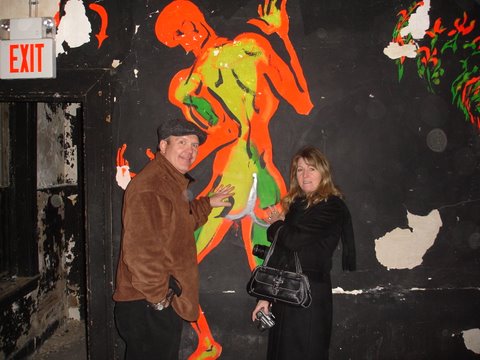
Dan and Eileen Chapman Inside The Upstage Club
Carrie: Coincidentally, and I swear I had no idea this was going on, Bruce was performing one of his Holiday Shows at the Convention Center in Asbury Park the very next night. Fortunately and with a little help from my friends, I was able to get into the show. And once I was inside I got it into my head that I had to make the most of my visit, including introducing myself to Bruce. So here I was, this young “whipper-snapper” from Texas with a shopping bag full of my Grandpa’s slides and completely full of myself. I was lucky enough to go backstage for a little white and said a quick hello to Southside Johnny, who was also performing at the Holiday Show. Of course, Southside was his usual self, cracking jokes and asking me more questions than I asked him. It was very funny.
But when it came to meeting Bruce, things got a little sketchy. Apparently he was struggling from a bad cold, but he still took time between the sound check and the show to meet me. He was very kind but a little shocked that such a small person from Texas had such a big idea. I think I kind of caught him off-guard, going on and on about my how I was Tom Potter’s granddaughter. And he told me that he wanted to meet with me some other time to talk about the project. I’m still hoping that we can meet someday soon so I can hand him a copy of the book.
But the show was great, and it gave me a chance to meet a ton of people, so that was awesome. After the show I hung around and was introduced to several key individuals. That was the night I met Vini “Maddog” Lopez who was very nice to me and he has become a true friend and solid supporter of this project.
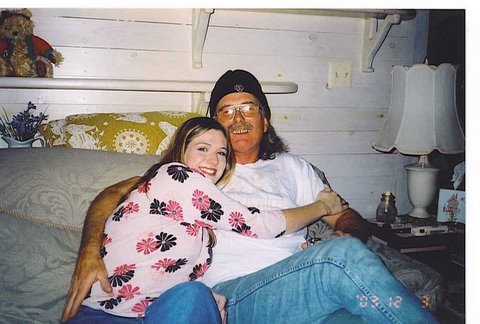
Carrie and Vini “Maddog” Lopez
This Hard Land: What happened next?
Carrie: Well, when I got back to my hotel I was informed that some important people were coming to meet me who were interested in helping me with this book. This turned out to be Dan “The Tape Man” Eitner and his wife Nancy. I can honestly say that without their love and support, I don’t know what I would have done. Dan is one of the most generous, thoughtful individuals that I have ever met. Ever since that first time I met Dan, he has helped me tremendously.
Dan just knows so many people and he has always had so many great ideas. Even now he’s constantly sending me inspirational emails and text messages that keep me going. I like to call him my unofficial “marketing director.”
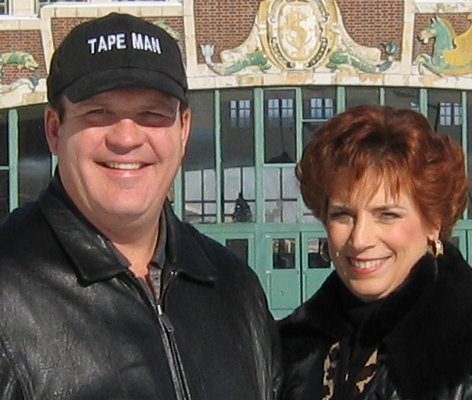
Dan and Nancy Eitner On The Boardwalk, Asbury Park, N.J.
Carrie: Really, when I think about it, I have been truly blessed by all of the wonderful and generous people who have taken an interest in this book. And I have to give a ton of credit to Joe Petillo and Tom Jones, who were both extremely helpful. Joe was actually an original member of Margaret Potter’s house band, The Distractions, at The Upstage. Tom Jones runs the Halo Group in Los Angelos and has an incredible media background.
When things were not looking very promising for the future of the building that The Upstage was in, Joe and Tom, as well as a number of original Upstage musicians decided to hold a “Last Jam” inside the Upstage, which I wrote about in detail in my book. In fact, Tom videotaped that jam for a documentary that he’s been working on about The Upstage. Both Joe Petillo and Tom Jones really gave me the strength to continue during the most difficult part of this journey.
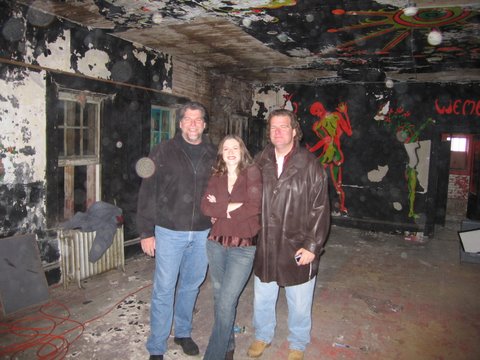
Joe Petillo, Carrie and Tom Jones
This Hard Land: What was it like the first time you got a chance to climb those steep steps and walked into The Upstage?
Carrie: You know in the movies when people finally reach the summit and they hear a choir of angels singing? That’s what it was like. In fact there’s one Disney remake, titled “The Secret Garden,” and there’s this scene where a little boy is entering the garden. That’s exactly how it felt. In fact, I get a little misty-eyed every time I think of it.
But getting upstairs wasn’t all that easy. On my first trip, I just walked into the old Extreme shoe store with a few of my new friends. There was an older Asian man running the store and no matter what we said he simply refused to let me go upstairs. He kept saying it wasn’t up to code and that I could get hurt and that kind of thing. I told him about my grandfather, Tom Potter, who ran The Upstage and how I had come all the way from Texas to see it. I tried everything, but he said it was too much of a safety liability for him to take a chance.
Well, then I turned on the water works. I got very emotional and started crying, saying, “I’m not leaving this store until you let me go upstairs.” (laughs) Finally, he gave in and grabbed the keys and up the stairs we went up, the whole group of us. And that’s when I heard the choir of angels singing. I felt like I was finally getting to see what I had been dreaming about for so long.

Steep Steps leading To The Upstage Club
This Hard Land: What was it like up there?
Carrie: Well, there wasn’t much left, just a few tables. But what was really cool was that much of the original art was still there on the wall. The paint was peeling a bit, of course. And there was the huge metal wall where Grandpa Tom used to put all the speakers. But a lot of the original artwork was still intact. The funniest thing was that when I went into the bathrooms there was all kinds of original writing on the walls and somebody had put up “Steel Mill.” I thought that was very, very cool.
But really, it remains today much like it did forty years ago. All of the fixtures are intact. And we had a great time, posing with various people for photos and checking out the place. Every time I come back to Asbury Park, I make sure to stop by and visit the place to make sure it’s all okay. I really hope that the new owner preserves it as much as possible. It really deserves to be preserved in some way as a museum and as a place for young people to come together. That’s my dream.
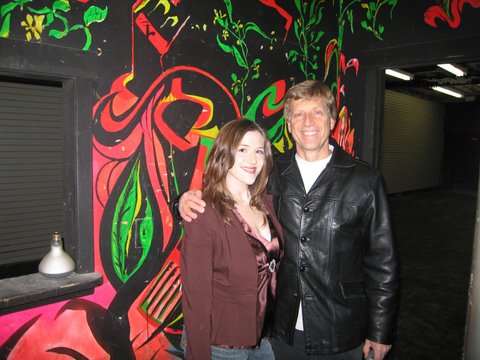
Carrie with Writer and Rock Historian Robert Santelli Inside The Upstage
This Hard Land: That first trip must have been quite inspiring for you.
Carrie: Oh, for sure. As soon as I got back to Texas, I got right to work. I started the Upstage.net website and I began asking people to send me their memories of the place. One of my biggest challenges was transferring the images from my grandfather’s slides, along with other illustrations to computer images that could be used for the book.
But one day while everything was on hold, my old high school art teacher, Paul Wilkins, and I were talking and I told him about my project and he was very excited about it. He immediately offered to help me transfer the slides. Paul and his wife Beverly took an immediate interest in this book and I’ve spent whole weeks at their house working on the book.
I would work for hours and hours on his computer until my arms were so tired I could barely lift them. Paul taught me the basics of this software program and let me go wild with it. He provided the tech support and gave me the creative freedom. In many ways, Paul and Beverly and Dan and Nancy were for me, what Tom and Margaret were for the kids who played at The Upstage. I could never have done this book without the help of many, many good friends.
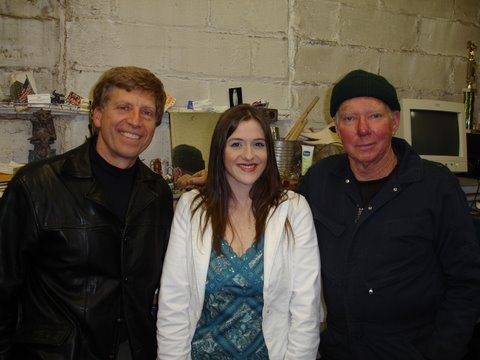
Robert Santelli, Carrie and The Legendary Carl “Tinker” West
This Hard Land: This book is, I think, a living and breathing testament to the kind of community that existed back in the 1960’s when The Upstage club was thriving and everyone sort of helped each other, lending guitars and amps. As for you, what are your plans? And what kind of vision do you have for the future of The Upstage?
Carrie: Well, I just had a new baby and as much as I’d love to dedicate all my time to mass marketing this book, I just don’t have the time. But I want so badly for this book to be a success, so buy a copy for yourself or somebody you love. It is a great gift and the holidays are coming up and I think anybody who is truly interested in the history of The Upstage would really learn a lot from this book.
Meanwhile, I’ll continue to do what I can. I’m going to keep flying to Asbury Park to do a number of book selling events in Asbury Park in the next few months, I plan to stay involved in helping to lobby city officials so the new owner can get what he needs to use this historic building most effectively.
Most of all, I’d like to see the building continue to be preserved. And I’d love to see it used as a sort of living museum and a place where young people and up and coming musicians can come together. That’s was my grandfather’s dream and now it’s my dream too.

